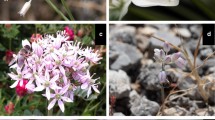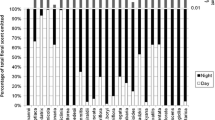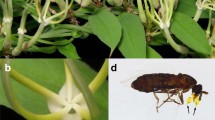Abstract
We investigated the scent composition of individual flowers of Ophrys sphegodes, its alteration following pollination, and of picked flowers by day and at night. Odor samples were collected by headspace sorption and analyzed by gas chromatography and mass spectrometry. To evaluate the function of postpollination odor changes, we carried out behavioral tests on the pollinator Andrena nigroaenea with pollinated and unpollinated flowers. We identified 27 volatiles in the flower scents. Aldehydes and alkanes were most frequently found. Aldehydes were the most abundant class of compounds (40–50%). When flowers were picked, they emitted significantly lower total amounts of volatiles than unpicked flowers, and their odor bouquets were significantly different. Comparison of scents released by day and at night showed no decrease in scent emission during nighttime, but the odor bouquets were significantly different. Pollinated flowers produced significantly different odor bouquets, and the total amount of scent emitted two to four days after pollination was significantly lower compared with unpollinated flowers. In addition, behavioral tests with A. nigroaenea males showed that flowers were significantly less attractive three days after pollination. This reduced attractiveness is hypothesized to guide pollinators to the unpollinated flowers within an inflorescence, and thus increase the reproductive success of the plant.
Similar content being viewed by others
REFERENCES
ARDITTI, J. 1979. Aspects of the physiology of orchids, pp. 422–697, in H. W. Woolhouse (ed.). Advances in Botanical Research 7. Academic Press, London.
AYASSE, M., ENGELS, W., HEFETZ, A., TENGö, J., LüBKE, G., and FRANCKE, W. 1993. Ontogenetic patterns of volatiles identified in Dufour's gland extracts from queens and workers of the primitively eusocial halictine bee, Lasioglossum malachurum (Hymenoptera: Halictidae). Insectes Soc. 40:41–58.
AYASSE, M., SCHIESTL, F. P., PAULUS, H. F., ERDMANN, D., and FRANCKE, W. 1996. Does an Ophrys plant cheat a pollinating male bee more than once? Proceedings, XX International Congress on Entomology, Firenze, p. 225.
BERGSTRÖM, G. 1978. Role of volatile chemicals in Ophrys-pollinator interactions, pp. 207–231, in G. Harborne, (ed.). Biochemical Aspects of Plant and Animal Coevolution. Academic Press, New York.
BORG-KARLSON, A.-K. 1987. Chemical basis for the relationship between Ophrys orchids and their pollinators. III. Volatile compounds of species in the Ophrys sections Fuciflorae and Bombyliflorae as insect mimetic attractants/excitants. Chem. Scr. 27:313–325.
BORG-KARLSON, A.-K. 1990. Chemical and ethological studies of pollination in the genus Ophrys (Orchidaceae). Phytochemistry 29(5):1359–1387.
BORG-KARLSON, A.-K., BERGSTRöM, G., and GROTH, I. 1985. Chemical basis for the relationship between Ophrys orchids and their pollinators. I. Volatile compounds of Ophrys lutea and O. fusca as insect mimetic attractants/excitants. Chem. Scr. 25:283–311.
BORG-KARLSON, A.-K., BERGSTRöM, G., and KULLENBERG, B. 1987. Chemical basis for the relationship between Ophrys orchids and their pollinators. II. Volatile compounds of O. insectifera and O. speculum as insect mimetic attractants/excitants. Chem. Scr. 27:303–311.
BYERS, J. A. 1989. Chemical ecology of bark beetles. Experientia 45:271–283.
CASPER, B. B., and LA PINE, T. R. 1984. Changes in corolla color and other floral characteristics in Cryptantha humilis (Boraginaceae): Cues to discourage pollinators? Evolution 38(1): 128–141.
ENGELS, W., ENGELS, E., LüBKE, G., SCHRöDER, W., and FRANCKE, W. 1990. Volatile cephalic secretions of drones, queens and workers in relation to reproduction in the stingless bee, Scaptotrigona postica (Hymenoptera: Apidae: Trigonini). Entomol. Gen. 15:91–101.
ENGELS, E., ENGELS, W., LüBKE, G., SCHRöDER, W., and FRANCKE, W. 1993. Age related patterns of volatile cephalic constituents in queens of the neotropical stingless bee, Scaptotrigona postica Latr. (Hymenoptera: Apidae). Apidologie 24:539–547.
FAEGRI, K., and VAN DER PUL, L. 1979. The Principles of Pollination Ecology, 3rd ed. Pergamon, Oxford.
FRANCKE, W., BARTELS, J., MEYER, H., SCHRöDER, F., KOHNLE, U., BAADER, E., and VITÉ, J. P. 1995. Semiochemicals of bark beetles—new results, remarks, and reflections. J. Chem. Ecol. 21:1043–1063.
GODFERY, M. J. 1925. The fertilisation of Ophrys speculum, O. lutea, and O. fusca. J. Bot. (London) 63:33–40.
GREGG, K. B. 1983. Variation in floral fragrances and morphology: Incipient speciation in Cycnoches? Bot. Gaz. 144(4):566–576.
HABICH, A., and GROB, K. 1984. Filter extraction in closed loop stripping analysis (CLSA). J. High Resolut. Chromatogr. Chromatogr. Commun. 7:492–494.
HUTCHINGS, M. J. 1987. The population biology of the early spider orchid, Ophrys sphegodes Mill. I. A demographic study from 1975 to 1984. J. Ecol. 75:711–727.
KAISER, R. 1993. Vom Duft der Orchideen, Edition Roche. F. Hoffman-La Roche AG, Basel.
KULLENBERG, B. 1961. Studies in Ophrys Pollination. Almquist & Wiksells Boktrykeri AB, Uppsala.
KULLENBERG, B. 1973. New observations on the pollination of Ophrys L. (Orchidaceae). Zoon (Suppl. 1):9–13.
KULLENBERG, B., and BERGSTRöM, G. 1973. The pollination of Ophrys orchids, pp. 253–258, in G. Benz et al. (eds.). Chemistry in Botanical Classification. Proceedings, Nobel Symposium 25. Stockholm.
KULLENBERG, B., and BERGSTRöM, G. 1975. Chemical communication between living organisms. Endeavour 34:59–66.
KULLENBERG, B., and BERGSTRöM, G. 1976a. The pollination of Ophrys orchids. Bot. Not. 129:11–20.
KULLENBERG, B., and BERGSTRöM, G. 1976b. Hymenoptera Aculeata males as pollinators of Ophrys orchids. Zool. Scr. 5:13–23.
LOUGHRIN, J. H., HAMILTON-KEMP, T. R., ANDERSEN, R. A., and HILDEBRAND, D. F. 1990. Volatiles from flowers of Nicotiana sylvestris, N. otophora, and Malus × Domestica: Headspace components and day/night changes in their relative concentrations. Phytochemistry 29(8):2473–2477.
NEILAND, M. R. M., and WILCOCK, C. C. 1995. Maximisation of reproductive success by European Orchidaceae under conditions of infrequent pollination. Protoplasma 187:39–48.
NILSSON, L. A. 1978. Pollination ecology and adaptation in Platanthera chlorantha (Orchidaceae). Bot. Not. 131:35–51.
NORUSIS, M. J. 1993. SPSS for Windows: Professional Statistics, SPSS Inc., Chicago.
PAULUS, H. F., and GACK, C. 1986. Neue Befunde zur Pseudokpoulation und Bestäuberspezifität in der Gattung Ophrys—Untersuchungen in Kreta, Süditalien und Israel, pp. 48–86 in K. Senghas and H. Sundermann (eds.). Probleme der Taxonomie, Verbreitung und Vermehrung europäischer und mediterraner Orchideen II. Sonderheft “Die Orchidee” (Hildesheim).
PAULUS, H. F., and GACK, C. 1990. Pollinators as prepollinating isolation factors: Evolution and speciation in Ophrys (Orchidaceae). Isr. J. Bot. 39:43–79.
PAULUS, H. F., and GACK, C. 1994. Signalfälschung als Bestäubungsstrategie in der mediterranen Orchideengattung Ophrys—Probleme der Artbildung und der Artabgrenzung. Eurorchis 92:45–71.
SMITH, B. H., and AYASSE, M. 1987. Kin-based male mating preferences in two species of halictine bees. Behav. Ecol. Sociobiol. 20:313–318.
TOLLSTEN, L. 1993. A multivariate approach to post-pollination changes in the floral scent of Platanthera bifolia (Orchidaceae). Nord. J. Bot. 13(5):495–499.
TOLLSTEN, L., and BERGSTRöM, J. 1989. Variation and post-pollination changes in floral odours released by Platanthera bifolia (Orchidaceae). Nord. J. Bot. 9:359–362.
VOGEL, S. 1962. Duftdrüsen im Dienste der Bestäubung: Über Bau und Funktion der Osmophoren. Akad. Wiss. Lit. (Mainz), Abh. Math.-Nat. Kl. 1962(10):1–165.
Author information
Authors and Affiliations
Rights and permissions
About this article
Cite this article
Schiestl, F.P., Ayasse, M., Paulus, H.F. et al. Variation of Floral Scent Emission and Postpollination Changes in Individual Flowers of Ophrys sphegodes Subsp. sphegodes . J Chem Ecol 23, 2881–2895 (1997). https://doi.org/10.1023/A:1022527430163
Issue Date:
DOI: https://doi.org/10.1023/A:1022527430163




